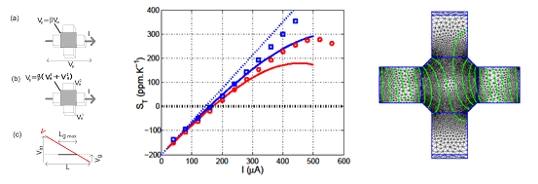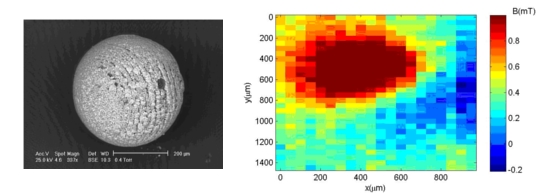Rechercher
Accueil > La Recherche > Axes & Equipes > Physique Appliquée > Transport Quantique & Nouveaux Systèmes 2D > Thème : Composants et Capteurs
GaAs/GaInAs/GaAlAs Hall sensors
publié le , mis à jour le
Hall sensors, based on GaAs/GaInAs/GaAlAs pseudomorphic heterostructures, can be used for metrological and microscopic applications like electricity metering or scanning magnetometer.
Electricity metering. The thermal drift cancellation of the magnetic sensitivity of Hall sensors used for electricity metering was the purpose of an industrial contract with ITRON-France and the main purpose of the E.R.T. project (Equipe de Recherche Technologique / ERT-4 Matériaux-µCapteurs-µSystèmes ; 2007-2010). We demonstrated that applying a voltage feedback onto a Schottky gate on top of a Hall device, it is possible to cancel the thermal drift of the magnetic sensitivity. In addition, tailoring the gate shape and/or the gate biasing scheme, we could adjust the Hall sensor bias current value for which the thermal drift vanishes.

A useful tool was the finite element method (FEM) analysis. Using FEM, we have calculated the Hall voltage of gated Hall sensors in the temperature range -55 °C, +125 °C. We investigated how both the sensor shape and the external connections influence the Hall voltage and its thermal drift. Combining altogether the FEM analysis and the experimental data, we concluded that FEM gives remarkable results for this problem : numerical results are in excellent agreement with the experimental measurements. FEM allows estimation a priori of the sensor characteristics with a limited choice of parameters or even without adjustable parameter. It is found that the thermal drift in the Hall voltage can be cancelled for a current of the order of 300 µA, a much higher value than that predicted by the corresponding analytical calculations (Thesis : L. Bouguen (2009)).
Improvements acquired in terms of thermal drift constituted one of the elements among others, taken into account by ITRON to introduce on the market a new generation of meters programmed from 2008.
Hall-probe for scanning magnetometers. When the sensor size becomes very small, new physics effects appear and a fundamental research is needed to understand the sensor response. Simultaneously, we continue to investigate the physics of small size sensors and we use a microscopic Hall-probe for developing scanning magnetometers dedicated to Earth and planetary sciences in the MagMap ANR project. Partners will intend to develop 3 complementary instruments : a scanning magnetic microscope based on the GMR (Giant Magneto Resistance) technology, a magnetic microscopy system using the magneto-optical Faraday effect, and a micro magnetometer using micro Hall probe. Complementariness between all these systems is in the sensitivity, spatial resolution and sensor-to-sample distance but type of measurement are different from one instrument to another.

Collaboration/Contract : Industrial contracts (CNRS-ITRON), ANR Magmap








